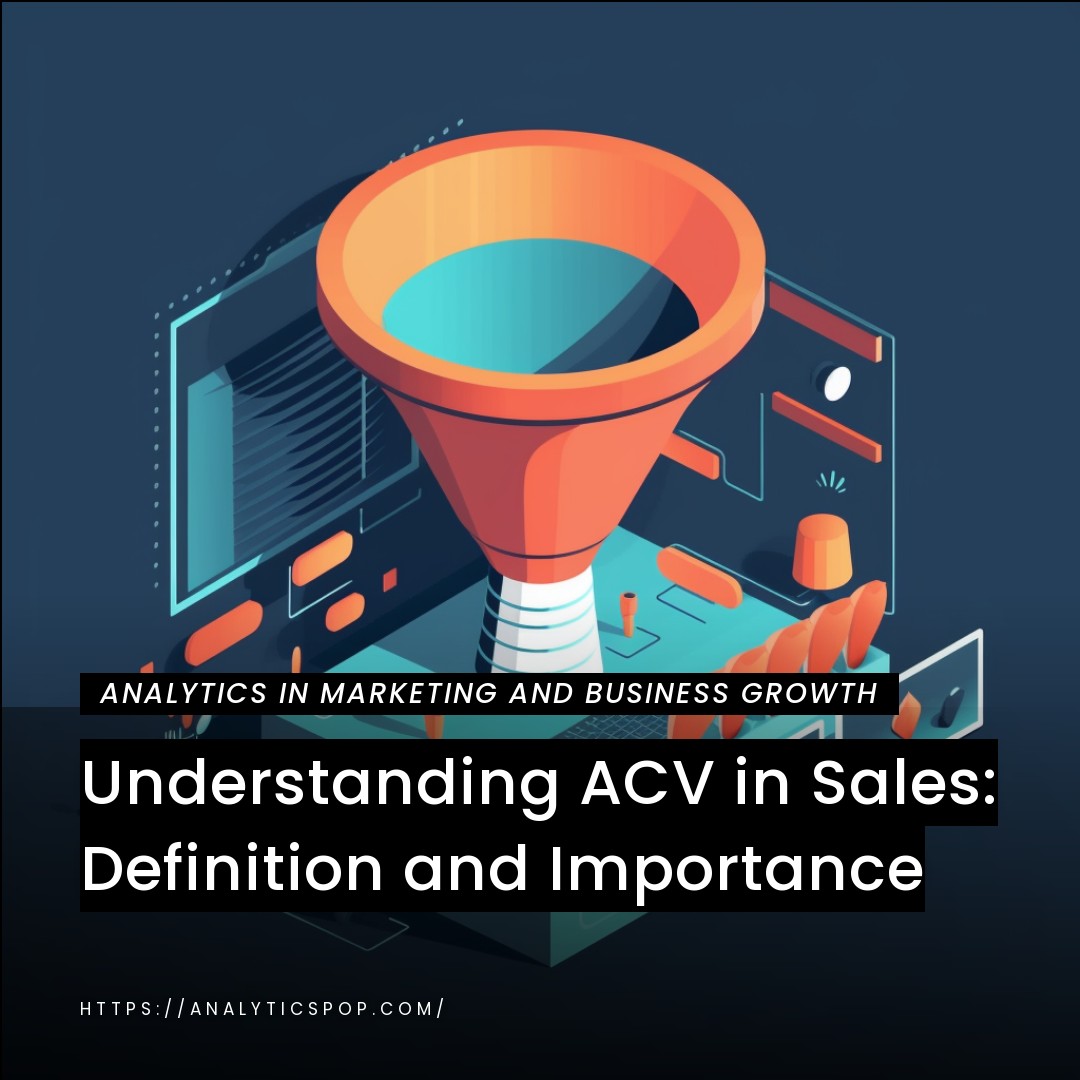Decoding ACV in Sales: Understanding its Definition and Importance
ACV, or Annual Contract Value, is a crucial metric used in sales to measure a customer’s average revenue within a year. It provides insights into the financial value of a customer relationship and helps businesses understand their sales performance. By decoding ACV, companies can better understand their revenue streams and make informed decisions to optimize their sales strategies.
ACV is calculated by multiplying the average contract value by the average contract duration. For example, if a customer signs a contract worth $10,000 annually for three years, the ACV would be $30,000.Understanding ACV is vital for businesses for several reasons.
- Firstly, it enables accurate revenue forecasting, allowing sales teams to set realistic targets and budgets.
- Secondly, ACV helps measure customer lifetime value, identifying high-value customers and prioritizing retention efforts.
- Furthermore, ACV assists in evaluating the success of different sales channels, pricing models, and customer segments, providing insights into which strategies drive revenue growth.
By analyzing ACV, businesses can make data-driven decisions, optimize sales performance, and focus on strategies that maximize revenue. It is a key performance indicator and a valuable tool for firms to gauge their sales effectiveness and overall financial health.
What is ACV?
ACV stands for Annual Contract Value. It is a metric used in sales and business to measure the average revenue generated by a customer within a year. ACV provides valuable insights into the financial value of customer relationships and helps companies evaluate their sales performance.
To calculate ACV, multiply the average contract value by the average contract duration. For instance, if a customer signs a contract worth $10,000 annually for two years, the ACV would be $20,000.Understanding ACV is crucial for businesses for several reasons.
- Firstly, it helps forecast and budget by providing a reliable estimate of expected revenue.
- Secondly, ACV enables companies to assess customer lifetime value and prioritize efforts to retain high-value customers.
- Additionally, it assists in evaluating the effectiveness of different sales channels, pricing models, and customer segments.
By analyzing ACV, businesses can make informed decisions, optimize sales strategies, and focus on revenue growth. It is a valuable tool for gauging sales performance and making data-driven decisions to drive business success.

Provide a clear definition of ACV in the context of sales and revenue generation
In the context of sales and revenue generation, ACV, or Annual Contract Value, refers to the average revenue a customer generates for a business within a year. It is a crucial metric used to measure the financial value of customer relationships and assess sales performance.
To calculate ACV, one multiplies the average contract value by the average contract duration. For example, if a customer signs a contract worth $10,000 monthly for twelve months, the ACV would be $120,000.ACV is vital in sales and revenue forecasting, providing insights into expected revenue streams over a specific timeframe. It aids businesses in setting realistic targets, allocating resources effectively, and making informed decisions about sales strategies.
Furthermore, ACV helps evaluate customer lifetime value, allowing businesses to identify high-value customers and prioritize efforts to nurture and retain them. By understanding the financial impact of customer relationships, companies can focus on maximizing revenue and long-term profitability.
ACV is a fundamental metric for assessing sales performance, forecasting revenue, and determining the value of customer relationships. It gives businesses valuable insights to make data-driven decisions and optimize their sales strategies for sustainable growth.
Explain how ACV is calculated and its relationship with customer contracts or subscriptions
ACV, or Annual Contract Value, is calculated by multiplying the average contract value by the average contract duration. This metric is closely tied to customer contracts or subscriptions and helps businesses understand the financial impact of these relationships.
To calculate ACV, you need to determine the average contract value. This involves summing up the total contract values of all customers and dividing them by the total number of customers. For example, if you have three customers with contract values of $10,000, $15,000, and $20,000, the average contract value would be ($10,000 + $15,000 + $20,000) / 3 = $15,000.Next, you need to determine the average contract duration. This is the average length of time that customers typically stay with your business under their contracts or subscriptions. For instance, if the average contract duration is two years, the average contract duration would be 2.
Finally, multiply the average contract value by the contract duration to obtain the ACV. Using the example values mentioned earlier, the ACV would be $15,000 * 2 = $30,000.The relationship between ACV and customer contracts or subscriptions lies in that ACV quantifies the average annual revenue generated from each customer relationship. It helps businesses assess the financial value of these contracts or subscriptions and make informed decisions about resource allocation, sales strategies, and customer retention efforts.
By tracking ACV over time, businesses can monitor the impact of changes in contract values or durations, identify trends, and gain insights into revenue forecasting and business growth. It serves as a valuable metric for understanding the financial health of customer relationships and optimizing revenue generation strategies.

Discuss the importance of ACV as a key metric for evaluating sales performance and forecasting revenue
ACV, or Annual Contract Value, is a key metric for evaluating sales performance and forecasting revenue. Here are the reasons why ACV is crucial in these aspects:
- Accurate Revenue Forecasting: ACV provides businesses with a reliable estimated expected revenue within a specific time frame. Companies can project their overall revenue and make more accurate forecasts by calculating the average revenue per customer annually. This helps set realistic targets, budget resources effectively, and plan for future growth.
- Sales Performance Evaluation: ACV is a valuable metric for assessing sales performance at individual and team levels. It allows businesses to analyze how effectively their sales efforts convert leads into customers and generate revenue. By monitoring changes in ACV over time, companies can identify areas of improvement, optimize sales strategies, and make data-driven decisions to enhance overall sales performance.
- Customer Lifetime Value Assessment: ACV helps evaluate customer lifetime value (CLV), the total revenue a customer generates during their entire relationship with a business. By understanding the ACV of customers, companies can identify high-value customers who contribute significantly to their revenue. This knowledge enables companies to focus on customer retention strategies, nurturing long-term relationships, and maximizing CLV.
- Strategy Evaluation and Resource Allocation: ACV aids in evaluating the success of different sales channels, pricing models, and customer segments. Analyzing ACV across these variables allows businesses to identify the most profitable channels and segments, allowing for targeted resource allocation and strategic decision-making. This ensures that resources are efficiently utilized to maximize revenue generation.
- Business Growth and Expansion: ACV is critical in determining a business’s financial health and growth potential. By tracking changes in ACV over time, companies can identify trends and assess the impact of pricing changes, product upgrades, or market shifts. This knowledge helps identify growth opportunities, make informed expansion decisions, and drive sustainable revenue growth.
ACV is a key metric for evaluating sales performance and forecasting revenue. It enables accurate revenue forecasting, aids in assessing sales effectiveness, helps evaluate customer lifetime value, assists in strategy evaluation, and supports business growth. By leveraging ACV as a critical performance indicator, businesses can optimize their sales efforts, make informed decisions, and maximize their revenue generation potential.
The Importance of ACV in Sales Analytics
ACV (Annual Contract Value) holds significant importance in sales analytics. It is a key metric that provides valuable insights and aids in making informed decisions. Here are some reasons highlighting the importance of ACV in sales analytics:
- Revenue Projection and Forecasting: ACV allows businesses to estimate their revenue streams accurately. By analyzing the average contract value and multiplying it by the average contract duration, companies can forecast their revenue for a given period. This helps set realistic sales targets, budget resources effectively, and plan for future growth.
- Sales Performance Evaluation: ACV is a vital metric to evaluate the performance of sales teams and individual sales representatives. It helps understand how effectively sales efforts convert leads into customers and generate revenue. By tracking ACV, businesses can identify improvement areas, measure sales strategies’ success, and make data-driven decisions to enhance overall sales performance.
- Customer Segmentation and Targeting: ACV assists in customer segmentation based on their contract values. Businesses can identify high-value customers by analyzing customer segments’ ACVs and allocating resources accordingly. This enables targeted sales and marketing efforts towards the most lucrative customer segments, maximizing revenue potential.
- Pricing Strategy and Profitability Analysis: ACV provides insights into the average revenue generated per customer. This information is valuable in assessing the effectiveness of pricing strategies. Businesses can identify the most profitable pricing structures by analyzing the relationship between ACV and pricing models and adjusting pricing to optimize revenue and profitability.
- Customer Lifetime Value (CLV) Assessment: ACV is closely related to CLV, which measures the total revenue generated by a customer over their entire relationship with a business. By understanding the ACV of customers, companies can evaluate their CLV and identify high-value customers who contribute significantly to long-term revenue. This knowledge helps in prioritizing customer retention efforts and maximizing customer lifetime value.
- Strategic Decision-Making: ACV aids in strategic decision-making by providing insights into the financial impact of different sales channels, product offerings, or market segments. Businesses can evaluate the success of various strategies based on ACV data and allocate resources accordingly. This ensures that resources are effectively utilized to drive revenue growth and overall business success.
ACV is a crucial metric in sales analytics. It facilitates revenue projection and forecasting, enables sales performance evaluation, supports customer segmentation and targeting, assists in pricing strategy and profitability analysis, helps assess customer lifetime value and aids in strategic decision-making. By leveraging ACV in sales analytics, businesses can optimize their sales strategies, make informed decisions, and maximize revenue generation potential.

Discuss the benefits of using ACV as a performance indicator for sales teams
Using ACV (Annual Contract Value) as a performance indicator for sales teams offers several benefits. Here are some of the key advantages:
- Revenue Focus: ACV helps sales teams focus on generating higher-value contracts and customers. By tracking and analyzing ACV, sales professionals can prioritize pursuing larger deals that significantly impact the company’s revenue. It shifts the focus from simply closing deals to closing deals with higher ACV, leading to increased revenue generation.
- Goal Setting and Target Achievement: ACV provides a measurable target for sales teams to strive for. Setting ACV targets enables sales professionals to work towards higher-value contracts and track progress. It helps align individual and team goals with the overall revenue objectives of the organization. By monitoring ACV achievements, sales teams can assess their performance and adjust to reach or exceed their targets.
- Performance Evaluation and Incentives: ACV serves as a valuable metric to evaluate the performance of sales teams and individual sales representatives. Companies can assess their sales strategies’ effectiveness by considering ACV as a performance indicator and identifying improvement areas. Sales professionals can be rewarded based on their ability to close deals with higher ACV, providing incentives for achieving and exceeding targets.
- Sales Strategy Optimization: Analyzing ACV data can provide insights into the effectiveness of different sales strategies, pricing models, or customer segments. Sales teams can identify patterns and trends in ACV and make data-driven decisions to optimize their sales strategies. This includes tailoring approaches for specific customer segments, refining pricing structures, or focusing on higher-value product offerings.
- Customer Relationship Management: ACV allows sales teams to identify high-value customers and nurture these relationships accordingly. By understanding the financial impact of customer contracts, sales professionals can prioritize customer retention efforts, provide tailored solutions, and focus on maximizing customer lifetime value. This leads to stronger customer relationships, increased customer satisfaction, and potential upselling or cross-selling opportunities.
- Revenue Forecasting and Resource Allocation: ACV provides crucial data for accurate revenue forecasting. Sales teams can project future revenue based on ACV trends and make informed decisions about resource allocation. It helps determine budget allocations, staffing requirements, and investment decisions, ensuring that resources are optimally utilized to drive revenue growth.
Using ACV as a performance indicator for sales teams offers benefits such as revenue focus, goal setting and target achievement, performance evaluation and incentives, sales strategy optimization, customer relationship management, and revenue forecasting and resource allocation. By leveraging ACV as a performance metric, sales teams can drive revenue growth, optimize strategies, and achieve higher levels of success.
Explain how ACV helps measure customer value, retention, and upsell opportunities
ACV (Annual Contract Value) plays a significant role in measuring customer value, retention, and upsell opportunities. Here’s how ACV contributes to these aspects:
- Customer Value Measurement: ACV helps measure the value of each customer by assessing the average revenue they generate within a year. By understanding the ACV of different customers, businesses can identify high-value customers who contribute significantly to their income. This knowledge allows companies to prioritize resources and efforts to retain and nurture valuable customer relationships.
- Customer Retention Assessment: ACV is a valuable metric for evaluating customer retention efforts. By analyzing changes in ACV over time, businesses can identify customers with decreasing ACV, indicating potential churn risks. This enables proactive measures to address issues and increase customer satisfaction, improving retention rates. ACV helps businesses monitor their retention strategies’ impact and identify improvement areas.
- Upsell and Cross-Sell Opportunities: ACV provides insights into potential upsell and cross-sell opportunities. By understanding the ACV of existing customers, businesses can identify customers whose ACV can be increased by selling additional products or services. For example, suppose a customer has a relatively low ACV but has the potential to benefit from higher-tier offerings. In that case, sales teams can focus on upselling to increase their ACV and overall revenue contribution.
- Customer Lifetime Value (CLV) Evaluation: ACV is crucial in calculating Customer Lifetime Value (CLV). CLV represents the total revenue a customer is expected to generate throughout their entire relationship with a business. By analyzing the ACV and considering the anticipated duration of the customer relationship, companies can estimate the long-term revenue potential of each customer. This information helps in strategic decision-making, resource allocation, and determining the overall value of the customer base.
- Targeted Marketing and Personalization: ACV data enables targeted marketing and personalized customer approaches based on their value. Businesses can tailor their marketing efforts, messaging, and offerings to high-value customers with higher ACV. By providing relevant and personalized experiences to these customers, businesses can strengthen relationships, increase customer satisfaction, and enhance upsell and cross-sell opportunities.
ACV helps measure customer value by assessing their average revenue contribution, evaluating customer retention efforts, identifying upsell and cross-sell opportunities, calculating CLV, and enabling targeted marketing and personalization. By leveraging ACV, businesses can optimize their customer strategies, maximize revenue from existing customers, and enhance overall customer value and satisfaction.

Highlight the role of ACV in identifying trends, market potential and making data-driven decisions
ACV, or Annual Contract Value, plays a role in identifying trends and market potential and facilitating data-driven decision-making in several ways:
- Identifying Trends: By analyzing the ACV of customer contracts over time, businesses can identify trends and patterns in revenue growth. Changes in ACV can indicate shifts in customer behavior, market demand, or the success of pricing strategies. For example, suppose the average ACV increases steadily over several periods. In that case, it may indicate a growing demand for higher-tier products or increased customer willingness to pay for additional features. These trends can inform product development, pricing adjustments, and marketing strategies.
- Assessing Market Potential: ACV can be used to assess the market potential for a product or service. By analyzing the ACV of existing customers or potential target customers, businesses can estimate the revenue potential within specific market segments. For instance, if a company calculates the ACV for a subset of customers within a particular industry or demographic, it can provide insights into the revenue opportunity available within that market. This information can guide sales and marketing efforts and resource allocation and help identify underserved or high-growth market segments.
- Making Data-Driven Decisions: ACV is a valuable data point for making informed decisions. It provides quantifiable information about the value of customer contracts and revenue streams. Businesses can gain a comprehensive understanding of their financial performance by analyzing ACV alongside other relevant data, such as customer acquisition costs, customer lifetime value, or churn rates. This data-driven approach enables enterprises to make informed decisions regarding product development, pricing strategies, sales and marketing initiatives, customer retention programs, and resource allocation.
ACV contributes to data-driven decision-making by providing insights into revenue trends, market potential, and financial performance. By leveraging ACV alongside other metrics and data sources, businesses can make more informed decisions, optimize strategies, and capitalize on growth opportunities.
FAQ's
How does ACV differ from MRR (Monthly Recurring Revenue)?
ACV (Annual Contract Value) and MRR (Monthly Recurring Revenue) are key metrics used to measure revenue in subscription-based business models. Still, they differ in terms of the period and level of granularity they represent. Here’s a breakdown of the differences between ACV and MRR:
- Time Period: ACV represents the total contract value for a customer over 12 months, while MRR represents the recurring revenue generated from monthly customer subscriptions. ACV provides a longer-term view of customer value, considering the contract’s entire duration, while MRR focuses on the ongoing monthly revenue stream.
- Granularity: ACV provides a higher level of granularity than MRR. ACV considers contract renewals, upsells, and any one-time fees, providing a comprehensive view of the revenue generated from a customer’s contract. MRR, on the other hand, captures only the recurring revenue from subscriptions and does not consider one-time charges or changes in contract terms.
- Flexibility: MRR provides a more flexible and agile revenue view on a monthly recurring basis. It allows businesses to quickly analyze revenue changes, monitor customer churn, and adapt pricing or subscription models accordingly. As an annual metric, ACV provides a longer-term perspective, helps track customer value over time, and identifies trends.
- Usage: ACV is often used in sales forecasting, financial reporting, and assessing the overall value of customer contracts. It helps understand customer segments, identify high-value customers, and evaluate the impact of upsells and renewals. MRR, on the other hand, is frequently used for operational purposes such as tracking monthly revenue, analyzing customer churn rates, and calculating key SaaS metrics like customer lifetime value (CLTV) and customer acquisition cost (CAC) ratios.
While ACV and MRR differ in their focus and period, they are both valuable metrics for understanding the revenue generated by a subscription-based business. By utilizing ACV and MRR, companies can comprehensively understand their revenue streams, customer value, and overall financial performance.

Can ACV be used as a predictor of future revenue growth?
ACV, or Annual Contract Value, is a metric commonly used in the software-as-a-service (SaaS) industry to measure the value of recurring revenue from customer contracts over 12 months. While ACV can provide insights into a company’s current revenue streams, it is not typically used as a direct predictor of future revenue growth.
Predicting future revenue growth involves considering market trends, customer demand, competitive landscape, product innovation, sales and marketing strategies, and overall business performance. ACV alone does not capture these factors and is limited to providing a snapshot of existing contract values.
Companies typically employ financial models, market analysis, historical performance data, sales pipelines, and other relevant metrics to forecast future revenue growth. These models consider a broader range of inputs and indicators to estimate revenue growth potential.
While ACV can help assess a company’s current revenue, it should be supplemented with other relevant information and forecasting methods to accurately predict future revenue growth.



